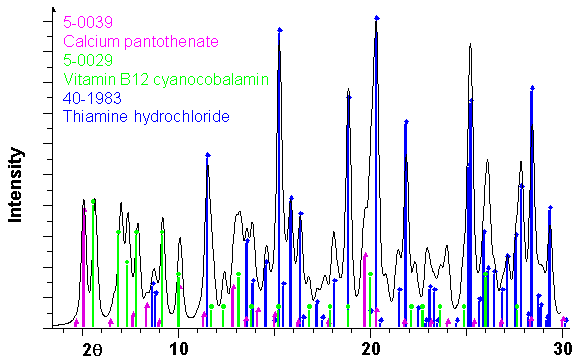Background
Forensic analysis on drugs and pharmaceuticals using XRD identifies compound purity and composition. The analysis is non-destructive and sensitive to the presence of both polymorphs and contaminants. Polymorphs are substances which are chemically identical but have different chemical activity in certain environments, like dextrose and levulose (two forms of C₆H₁₂O₆). Only dextrose is useful to most life forms. A number of instruments can determine the difference between them, but XRD can do it in their solid (crystalline) forms. X-ray diffraction is commonly used to determine the cutting agents used in illegal drugs because it is non-destructive, can be performed on the crystalline form of the drug, and requires no sample preparation. The analysis can be a quantitative experiment where the concentrations of the drug and any additional agents used to reduce the potency are determined. With X-ray microdiffraction, very small amounts can be detected. That means, the container that previously held the substance can be scanned for residues.
Investigation
In Figure 1, simulated diffraction patterns of cocaine and maltose are displayed along with the peak positions of the International Centre for Diffraction Data (ICDD) standard. Two mixtures, 50% cocaine / 50% maltose and 10% cocaine / 90% maltose, show the qualitative differences in the XRD pattern as the components are varied. Qualitative identification is based on the presence of the unique diffraction lines for each substance, the "X-ray fingerprint." In addition, a quantitative determination can be made for each component by measuring its peak intensity and comparing it to the intensities measured from one or more samples of known concentration.

Vitamins are another group of materials commonly tested with XRD. The wrong polymorph of a vitamin is usually inert and provides no benefit to the consumer. For example, the B vitamin pantothenic acid has two polymorphs, one of which is inert. The data in Figure 2 is from a B-complex vitamin supplement. Using XRD it is possible to identify each component, and whether the correct polymorph is present to ensure proper potency.

Both qualitative and quantitative analysis can be performed on the same data set. The qualitative composition or phase identification is determined by the position of the peaks in the measured XRD pattern compared with the peak position and intensity data found in the ICDD Powder Diffraction File (PDF). Quantitative analysis is performed by determining the intensity of peaks for each component. It can be performed on a relative basis by comparing two or more samples to obtain a ratio, or by direct methods using standards of known composition. As in most XRD analysis, the sample is not destroyed and little or no preparation is needed. Tablets can be measured directly, but if the tablet is coated, a part of the coating must be removed to expose the contents.
